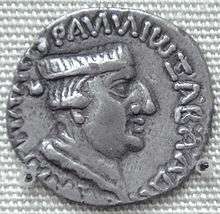Nahapana
| Nahapana | |
|---|---|
| Western Satrap | |
 Silver coin of Nahapana, with ruler profile and pseudo-Greek legend "PANNIΩ ΞAHAPATAC NAHAΠANAC", transliteration of the Prakrit "Raño Kshaharatasa Nahapanasa" (or "King Kshaharata Nahapana"). British Museum. | |
| Reign | 1st or 2nd century CE |
| Predecessor | Bhumaka |
Nahapana (r. 1st or 2nd century CE) was an important ruler of the Western Kshatrapas, descendant of the Indo-Scythians, in northwestern India. According to one of his coins, he was the son of Bhumaka.
Period
The exact period of Nahapana is not certain. A group of his inscriptions are dated to the years 41-46 of an unspecified era. Assuming that this era is the Shaka era (which starts in 78 CE), some scholars have assigned his reign to 119-124 CE.[1] Others believe that the years 41-46 are his regnal years, and assign his rule to a different period. For example, Krishna Chandra Sagar assigns his reign to 24-70 CE.[2]
Reign
The Periplus of the Erythraean Sea mentions one Nambanus as the ruler of the area around Barigaza. This person has been identified as Nahapana by modern scholars. The text describes Nambanus as follows:[3]
| “ | Beyond the gulf of Baraca is that of Barygaza and the coast of the country of Ariaca, which is the beginning of the Kingdom of Nambanus and of all India. That part of it lying inland and adjoining Scythia is called Abiria, but the coast is called Syrastrene. It is a fertile country, yielding wheat and rice and sesame oil and clarified butter, cotton and the Indian cloths made therefrom, of the coarser sorts. Very many cattle are pastured there, and the men are of great stature and black in color. The metropolis of this country is Minnagara, from which much cotton cloth is brought down to Barygaza. | ” | |
| — Periplus 41[4] | |||

He also established the Kshatrapa coinage, in a style derived from Indo-Greek coinage. The obverse of the coins consists of the profile of the ruler, within a legend in Greek. The reverse represents a thunderbolt and an arrow, within Brahmi and Kharoshthi legends.
Nahapana is mentioned as a donator in inscriptions of numerous Buddhist caves in northern India. The Nasik and Karle inscriptions refer to Nahapana's dynastic name (Kshaharata, for "Kshatrapa") but not to his ethnicity (Saka-Pahlava), which is known from other sources.[5]
Nahapana had a son-in-law named Ushavadata (Sanskrit: Rishabhadatta), whose inscriptions were incised in the Pandu-lena caves near Nasik. Ushavadata was son of Dinika and had married Dakshamitra, daughter of Nahapana. According to the inscriptions, Ushavadata accomplished various charities and conquests on behalf of his father-in-law. He constructed rest-houses, gardens and tanks at Bharukachchha (Broach), Dashapura (Mandasor in Malva), Govardhana (near Nasik) and Shorparaga (Sopara in the Thana district). He also campaigned in the north under the orders of Nahapana to rescue the Uttamabhadras who had been attacked by the Malayas (Malavas). He excavated a cave (one of Pandavleni Caves) in the Trirashmi hill near Nasik and offered it to the Buddhist monks.[6]
Overstrikes of Nahapana's coins by the powerful Satavahana king Gautamiputra Satakarni have been found in a Southern Gujarat hoard at Jogalthambi. However, it is not necessary that Gautamiputra Satakarni and Nahapana to be contemporaries since Satakarni mentions that the areas he has conquered were ruled by Ushavadata, rather than Nahapana. According to archaeologist James Burgess, there might have been an interval of as much as a century between the reigns of these two kings.[7][8]
Nahapana was founder of one of the two major Saka Satrap dynasties in north-western India; the other dynasty included the one founded by Chashtana.[9]
Notes
- ↑ Buddhist Reliquaries from Ancient India. British Museum Press. 2000. p. 42. ISBN 978-0-7141-1492-7.
- ↑ Krishna Chandra Sagar (1992). Foreign Influence on Ancient India. Northern Book Centre. p. 133. ISBN 978-81-7211-028-4.
- ↑ "The mention of 'Nambanus' whom the scholars have identified as Nahapana in the Periplus of the Erythrean Sea would help us to solve the problem of Nahapana's time.", in "History of the Andhras" Archived March 13, 2007, at the Wayback Machine.
- ↑ quoted in "The Periplus of the Erythraean Sea: Travel and Trade in the Indian Ocean by a Merchant of the First Century". Fordham University. Retrieved 11 May 2013.
- ↑
- ↑ Magarastra.gov.in Ancient Period Archived March 3, 2007, at the Wayback Machine.
- ↑ Burgess, James (1880). The Cave Temples of India. Cambridge University Press. pp. 266–268. ISBN 978-1-108-05552-9.
- ↑ Chattopadhyaya, Sudhakar (1974). Some Early Dynasties of South India. Motilal Banarsidass. p. 77. ISBN 978-81-208-2941-1.
- ↑ Students' Britannica India. 4. Encyclopædia Britannica. 2000. p. 375.
References
- R.C. Senior "Indo-Scythian coins and history" Vol IV, ISBN 0-9709268-6-3
External links
- , by Durga Prasad, with numerous references to Nahapana.
- Coins of Nahapana
- More coins of Nahapana
- Coins with biography
